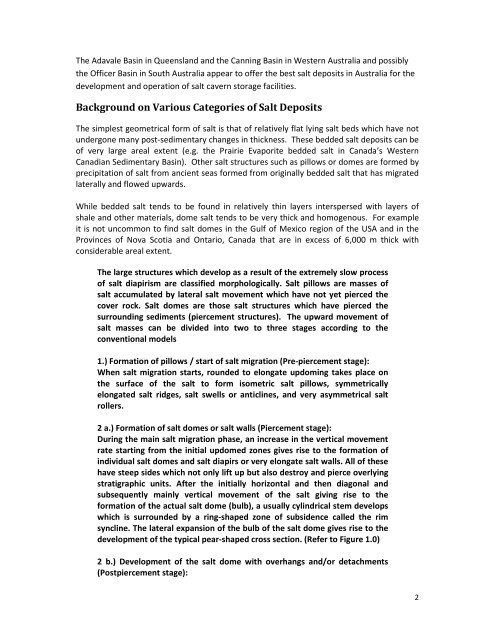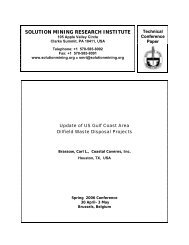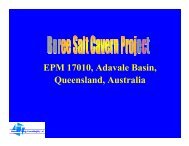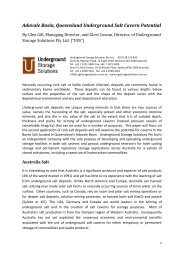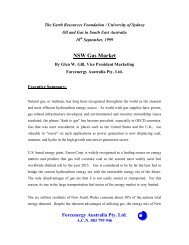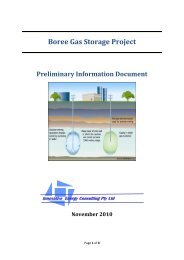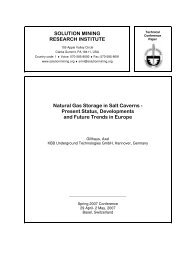Mining Journal - Innovative Energy Consulting - Brisbane, Australia
Mining Journal - Innovative Energy Consulting - Brisbane, Australia
Mining Journal - Innovative Energy Consulting - Brisbane, Australia
You also want an ePaper? Increase the reach of your titles
YUMPU automatically turns print PDFs into web optimized ePapers that Google loves.
The Adavale Basin in Queensland and the Canning Basin in Western <strong>Australia</strong> and possibly<br />
the Officer Basin in South <strong>Australia</strong> appear to offer the best salt deposits in <strong>Australia</strong> for the<br />
development and operation of salt cavern storage facilities.<br />
Background on Various Categories of Salt Deposits<br />
The simplest geometrical form of salt is that of relatively flat lying salt beds which have not<br />
undergone many post-sedimentary changes in thickness. These bedded salt deposits can be<br />
of very large areal extent (e.g. the Prairie Evaporite bedded salt in Canada’s Western<br />
Canadian Sedimentary Basin). Other salt structures such as pillows or domes are formed by<br />
precipitation of salt from ancient seas formed from originally bedded salt that has migrated<br />
laterally and flowed upwards.<br />
While bedded salt tends to be found in relatively thin layers interspersed with layers of<br />
shale and other materials, dome salt tends to be very thick and homogenous. For example<br />
it is not uncommon to find salt domes in the Gulf of Mexico region of the USA and in the<br />
Provinces of Nova Scotia and Ontario, Canada that are in excess of 6,000 m thick with<br />
considerable areal extent.<br />
The large structures which develop as a result of the extremely slow process<br />
of salt diapirism are classified morphologically. Salt pillows are masses of<br />
salt accumulated by lateral salt movement which have not yet pierced the<br />
cover rock. Salt domes are those salt structures which have pierced the<br />
surrounding sediments (piercement structures). The upward movement of<br />
salt masses can be divided into two to three stages according to the<br />
conventional models<br />
1.) Formation of pillows / start of salt migration (Pre-piercement stage):<br />
When salt migration starts, rounded to elongate updoming takes place on<br />
the surface of the salt to form isometric salt pillows, symmetrically<br />
elongated salt ridges, salt swells or anticlines, and very asymmetrical salt<br />
rollers.<br />
2 a.) Formation of salt domes or salt walls (Piercement stage):<br />
During the main salt migration phase, an increase in the vertical movement<br />
rate starting from the initial updomed zones gives rise to the formation of<br />
individual salt domes and salt diapirs or very elongate salt walls. All of these<br />
have steep sides which not only lift up but also destroy and pierce overlying<br />
stratigraphic units. After the initially horizontal and then diagonal and<br />
subsequently mainly vertical movement of the salt giving rise to the<br />
formation of the actual salt dome (bulb), a usually cylindrical stem develops<br />
which is surrounded by a ring-shaped zone of subsidence called the rim<br />
syncline. The lateral expansion of the bulb of the salt dome gives rise to the<br />
development of the typical pear-shaped cross section. (Refer to Figure 1.0)<br />
2 b.) Development of the salt dome with overhangs and/or detachments<br />
(Postpiercement stage):<br />
2


